ARTIGO/ARTICLE
Mosquito control based on larvicides in the state of Rio Grande do Sul, Brazil: choice of the control agent1
Controle de mosquitos com base em larvicidas no estado do Rio Grande do Sul, Brasil: a escolha do agente de controle
Antônio L. Ruas-Neto; Sydnei M. Silveira; Evandro Ricardo da C. Colares
Vector and Zoonoses Division, State Department of Environment and Public Health. Av. Vigário José Inácio 303/6º, Porto Alegre, RS. 90020-100, Brasil
ABSTRACT
A comparison between chemical and biological larvicides in routine operations against mosquitoes in Rio Grande do Sul State was carried out in this study.
In laboratory bioassays against Culex quinquefasciatus, biological formulations Vectobac 12 AS and Teknar 3000 (Bacillus thuringiensis israelensis) as well as ABG 6262 (B. sphaericus 2362), both in liquid and powder form, were highly effective. Locally produced B.thuringiensis israelensis, formulations also yielded good results. Among chemical larvicides, pyrethroid compounds Pirisa and K-Othrine yielded better results than the organophosphates Lebaycid and Abate. These last formulations yielded responses ten weaker than predicted in other studies.
Under field conditions, a dose of 1250 mg/m2 for biological formulations was considered adequate for routine application because at this level it is possible to overcome physical influences on results. Only B.sphaericus preparations caused important disruption of mosquito colonization in active breeding sites. Up to 39 weeks were tabulated without complete colonization in natural conditions and one month in artificially colonized tanks.
This study suggests that biological alternatives should be considered in mosquito control programs. They may be a solution to such problems as resistance to larvicides, elimination of natural enemies, and short-lasting effects of applications.
Key words: Mosquitoes; Larvicides; Biological Control
RESUMO
Desenvolveu-se neste estudo uma comparação entre larvicidas químicos e biológicos usados em programas de controle de mosquitos no Rio Grande do Sul.
Em bioensaios de laboratório contra Culex quinquefasciatus constatou-se que as formulações biológicas líquidas Vectobac 12 AS e Teknar 3000 (Bacillus thuringiensis israelensis), ABG 6262 líquido e em pó (B. sphaericus 2362), foram altamente eficazes. Também as formulações experimentais de B. thuringiensis israelensis produzidas em laboratórios brasileiros foram consideradas adequadas. Entre as formulações químicas, os compostos piretróides Pirisa e K-Othrine produziram resultados melhores do que os organo-fosforados Lebaycid e Abate. Estes últimos produziram respostas dez vezes mais fracas do que o previsto em outros estudos. Em condições de campo, a dose de 1250 mg/m2 para as formulações biológicas foi considerada adequada para a rotina das aplicações, porque permite superar as influências físicas do meio sobre os resultados. Somente as formulações de B. sphaericus produziram interrupções nas reinfestações dos focos de culicídeos observados. Períodos de até 39 semanas sem reinfestações foram observados em focos naturais e de um mês sem sobrevivência foi observado em tanques, onde procedia-se a reinfestação artificial.
Este estudo sugere que as alternativas biológicas devem ser consideradas em programas de controle de mosquitos. Elas podem superar os problemas de resistência e eliminação, bem como da ausência de efeito residual nas aplicações de larvicidas.
Palavras-Chave: Mosquitos; Culex sp; Bacillus sp; Larvicidas; Controle Biológico
INTRODUCTION
Mosquitoes are major disease vectors as well as nuisance insects and are therefore relevant to control programs in Brazil. Most of these programs still rely on techniques that eliminate adult mosquitoes. Nevertheless, recent concerns related resistance, environmental damage, and safety for operators have stimulated a discussion on alternate methods for controlling these vectors and have highlighted the importance of actions against mosquito larvae and their breeding sites (Ruas-Neto & Oliveira, 1985).
Methods for using larvicides have not been extensively studies in recent years in Brazil and important problems such as choice of the agent and application procedures have not been resolved. The present study, carried out in the State. Rio Grande do Sul, analyzes some of the advantages and disadvantages of several larvicides agents (Ruas-Neto & Silveira, 1989).
LABORATORY TESTS AGAINST MOSQUITOES
Laboratory bioassays were carried out from July 1989 to March 1991. They employed laboratory reared speciment of Culex quinquefasciatusa Say, the target species for nearly all local control programs in Rio Grande do Sul (Ruas-Neto, 1989).
Rearing techniques used for C. quinquefasciatus were similar to those described in a previous study, with some adaptations (Ruas-Neto & Silveira, 1989). The optimal diet for larvae was a mixture of ground concentrated catfood pellets, yeast powder, and rabbit dung at a ratio of 7:2:1. A fourteen-hour period of light was supplied, but temperature was not completely stable. Adults were fed on common sugar and weekly blood meals were obtained from quails (Nothura maculosa).
Early four-instar larvad (5 mm) were always used for tests. Selected individual results were pooled and then analyzed on a log-probit basis. The number of replicates for each formulation was not determined. Individual results with close standard lethal concentrations (LC50 and LC90) were selected. For each group of tests, the variation coefficient of lethal concentration values was less than 20%.
Formulations used in the tests are shown in Table 1. Dilutions were always prepared immediately before use and readings were done after 24 hours.
TABLE 1. Larvicides Formulations
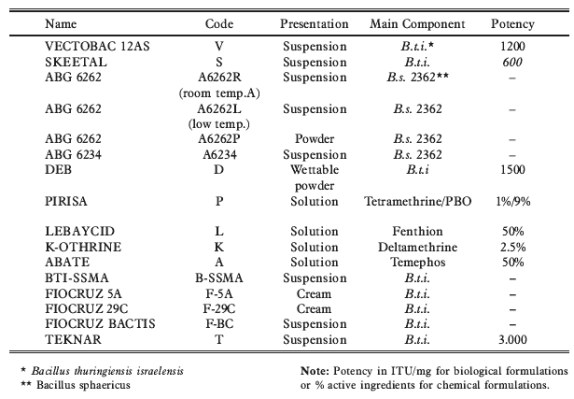
FIELD TESTS
Field tests were carried out in locations described in Table 2, from August 1989 and December 1990. For determination of immediate responses, tests were carried out either using netted cylinders (1 m high,0.5 m wide with 1 mm mesh) to limit the area, or over the entire experimental area. The density unit used was the mean number of larvae per dip of 200 ml MLPD. Dips were always taken along the margins to ensure uniformity of sample. Reductions in this mean were used as estimates of larval mortality.
TABLE 2. Sites for Field Tests
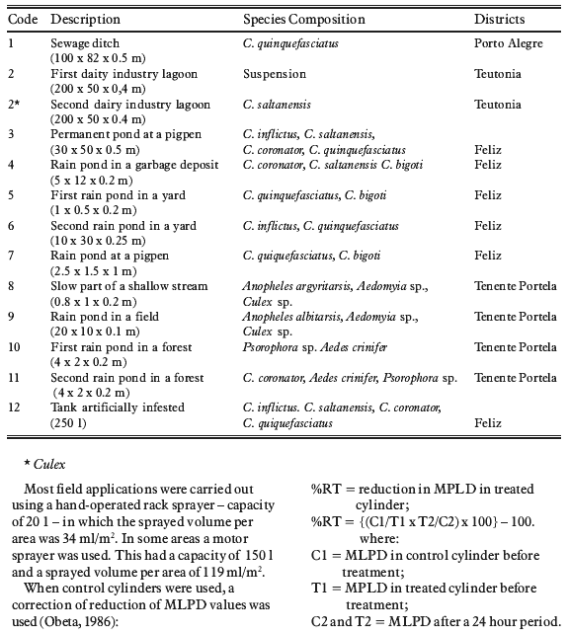
Larvae were sampled and sifted through a nylon sieve (1 mm mesh) to retain L3 and L4 larvae, which were then used for calculation of MLPD. Dips were taken until the variation coefficient of larvae per dip counts was less than or equal to 20%. MLPD values were compared as anti-log means of log-transformed counts in every test (Elliot, 1983).
Tests over entire experimental areas were evaluated according to observed reduction of MLPD in the area or %RT, after 24 hours as follows:
%RT: {(SR/IR) x 100} 100 where, IR: initial reading of MLPD in entire area (before treatment). SR: sequential reading of MLPD in entire area (after treatment).
Most field applications were carried out using a hand-operated rack sprayer capacity of 20 1 in which the sprayed volume per area was 34 ml/m2. In some areas a motor sprayer was used. This had a capacity of 150 l and a sprayed volume per area of 119 ml/m2.
When control cylinders were used, a correction of reduction of MLPD values was used (Obeta, 1986):
%RT = reduction in MPLD in treated cylinder;
%RT = {(C1/T1 x T2/C2) x 100} 100. where:
C1 = MLPD in control cylinder before treatment;
T1 = MPLD in treated cylinder before treatment;
C2 and T2 = MLPD after a 24 hour period.
Test with reductions in MLPD in control cylinders over 30% were discarded.
Residual effect of biological larvicides was followed sprayed open areas and in tanks of 250 l, observed in October 1990. Tanks were kept full of field water and received larvae periodically. Twenty dips of 600 ml with larvae were added every day of readings. Immediate reduction in treated tanks was calculated as %RT, similar to cylinder situation. Variation of MLPD in the control tank was observed according to the parameter %RC, or reduction in MLPD considering the first reading. Residual effect in the treated tank was calculated as %RR, a reduction in MLPD in the treated tank considering sequential readings in the control tank:
%RC = {(IRC/SRC) X 100} 100, where:
IRC = INITIAL MLPD in control tank.
SRC = sequential reading in control tank.
%RR = {(SRT/SRC) x 100} 100, where:
SRT = sequential reading in treated tank.
RESULTS
Table 3 presents probit analysis of bioassays carried out during spring and summer seasons. A temperature effects observed during colder seasons was not analyzed (Ruas-Neto, 1987).
TABLE 3. Bioassay Results
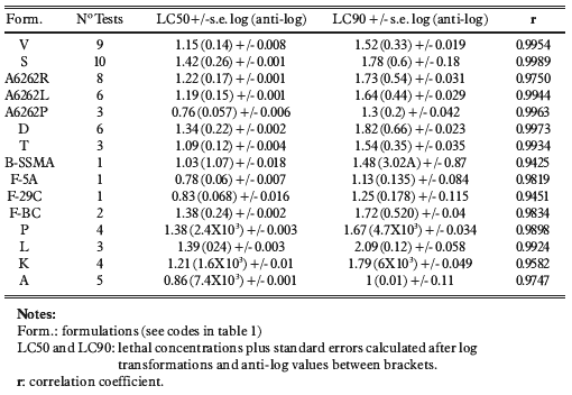
Table 4 presents results observed in field tests with cylinders, were doses are mg of product per arca. Chemical larvicides have doses presented as active ingredient per arca. Estimates of concentrations could be obtained considering a depth range of 0.1 to 0.5 m in each site. Table 5 presents immediate results of field tests with biological larvicides at a dose of 1250 mg/m2. Residual effect in these sites is shown in Figure 1, as a number of weeks where a reduction of MLPD (%RT) of 90% or higher was observed, compared to initial readings. Table 6 and Figure 2 show results in tanks. Observation of B. thuringiensis israelensis application Vectobac, was discontinued after one week, when the residual effects started decreasing.
TABLE 4. Field Tests with Cylinders
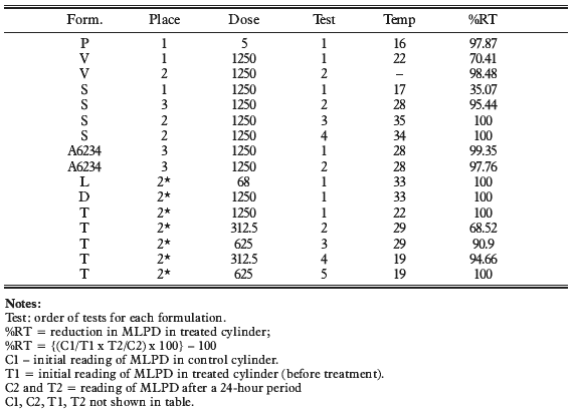
TABLE 5. field Tests in Entire Areas

TABLE 6. Residual Effect in Tanks of 250 l
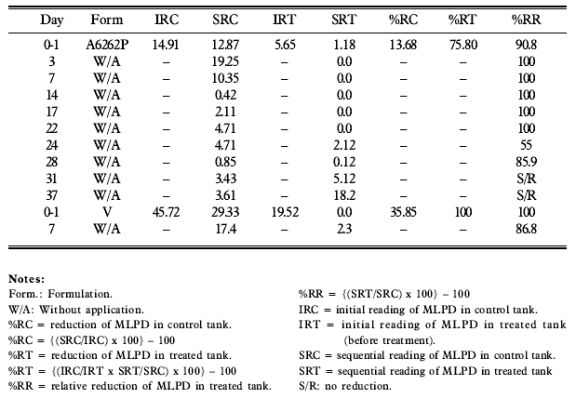
FIGURE 1. Residual Effect of B. thuringiensis israelensis and B. sphaericus in Entire Experimental Areas

FIGURE 2. Residual Effect of B. thuringiensis israelensis and B. spharicus in Tanks

DISCUSSION
An overall good response was observed in the bioassays with biological formulations Vectobac, Teknar and ABG 6262. Liquid Skeetal and powder DEB produced poorer responses. Experimental B. thuringiensis israelensis formulations F-5A and F-29C produced excellent results, suggesting that investment in production of such formulations could be cost-effects (Ruas-Neto & Silveira, 1989).
Pyrethroid larvicides K-Othrine and Pirisa produced results within expectations. In contrast, lethal concentrations of organophosphorates Lebaycid and Abate were considered ten times higher than in other studies, suggesting some tolerance of C. quinquefasciatus to those compounds (Brow, 1986).
Liquid B. sphaericus preparations stored at room temperature A6262R and in the refrigerator A6262L produced similar results, although heterogeneity of individual tests was much higher in the first case, Further tests are needed to assess the effects of storage temperature.
Table 4 shows that good overall responces to biological formulations under field conditions were obtained at the dose of 1250 mg/m2. Differences in water quality did not influence the results, except in one situation a sewage ditch, site I where some result were poorer. A sharp decrease is expected in the immediate effect at lower doses in organically enriched environments (Sinegre et al., 1980; Mulla et al., 1988; Mulla et al., 1984). Teknar yielded lower reductions in MLPD when doses were 50% or 25% of the above dose. Depth differences did not influence results, suggesting that effectiveness is more related to particle concentrations of the upper layer of the water (Mulla et al., 1988).
Table 6 shows that Vectobac, ABG 6262 and ABG 6262P were lighly effective regardless of the species composition of the site. Predatory C. (Lutzia) bigoti was also reduced, probably by eating moribund larvae.
Persistence of biological larvicides in the media has been discussed on several occasions (Lacey et al., 1984; Clark III & Rowley, 1984; Mulla et al., 1984; Balarman et al., 1987). The overall conclusion is that B. sphaericus based formulations are superior to B. thuringensis israelensis examples. In some B. sphaericus strains such as 2362, toxic particles are embedded in the spore and become more protected against physical factors (Karch e Charles, 1987). In B. thuringiensis israelensis, toxic particles are crystals released in the medium and therefore less protected. Also, B. sphaericus strains produce a higher rate of bacterial multiplication in larval bodies than B. thuringiensis israelensis, promoting a partial recycling after released in the medium (Roberts & aGarcia, 1984; Aly et al., 1985).
B. thuringiensis israelensis preparations usually present a short-lasting effect under field conditions (Clark III & Rowley, 1984). Solid slow-releasing formulations may extend this period to two or three weeks (Lacey et al., 1988; Lecy et al., 1984). In contrast, longer periods have been observed with B. sphaericus formulations. Periods of one or two months have observed in some studies on B. sphaericus persistence (Lacey et al., 1984; Mulla et al., 1984). In this study we observed that B. sphaericus effect in artificially infested tanks persisted for one month, much longer than the B. thuringiensis israelensis effect (Table 6 and Figure 2). Under natural conditions, a heavily-infested small body of water, culicines remained controlled for nine months after one B. sphaericus. application (the effect in place 7 in Figure 1). The B. sphaericus effect probably ends when spores settle to the bottom of the medium (Balarman et al. 1987). Toxic particles of B. sphaericus spores are probably destroyed in the mud, but the spores remain viable (Karch & Charles, 1987).
Additional factors that can extend the residual effect of biological larvicides are population interactions and depth of the sites. We observed in some sites that C. quinquefasciatus was replaced by less important species after some applications (the effect in site 3 shown in Figure 1). Also, deeper bodies of water appeared to favour persistence of biological larvicides. In contrast, shallow sites or ditches where water is moving probably shorten the effect period.
In some places it is necessary to preserve diversity of organisms, specially those competitors to or predators upon target culicines. In such situations biological larvicides should be chosen. Chemical larvicides ate largely nonselective (Mohsen & Mulla, 1981; Frost & Sinniah, 1982), affecting even vertebrates in some cases (Zinkl et al., 1981). Such larvicides should be used only in places where pollutions is too high to allow for biological diversity, provided that they ate more cost-effective than biological examples.
ACKNOWLEDGEMENTS
We thank Dr. B. Dobrokhotov for his assistance in this study on behalf of TDR-WHO; Dr. L. Rabinovitch of the Oswaldo Cruz Institute, Dr. R. Matias of ICI do Brasil, MR. C. T. Pinto of Quimio Ind. Quim., Mr. J. Mader of Defensa Ind. Defens. Agr. and Mr. N. Batastini of Pirisa Piretro Ind. for supplying products and supporting this study.
REFERENCES
ALY, C.; MULLA, M. S. & FREDERICI, B. A., 1985. Sporulation and toxin production by Bacillus thuringiensis var. israelensis in cadavers of mosquito larvae (Diptera: Culicidae). Journal of Invertebrate Pathology, 46: 251-258.
BALARMAN, K.; GUNASEKARAN, K.; PILLAI, P. K. G. K. & MANONMANI, A. M., 1987. Field trial with different formulations of Bacillus sphaericus for mosquito control. Indian Journal of Medical Research, 85: 620-625.
BROW, A. W. A., 1986. Insecticide resistance in mosquitoes: a pragmatic review. Journal of American Mosquito Control Association, 2: 123-140.
CLARK III, J. L. & ROWLEY, W. A., 1984. Evaluation of granular Bacillus thuringiensis var. israelensis (serotype H-14) formulations against mosquito larvae in Central lowa. Mosquito News, 44: 502-505.
ELLIOT, J. M., 1983. Some Methods for the Statistical Analysis of Samples of Benthic Invertebrates. Ambleside-Cumbria: Freshwater Biological Association.
FROST, S. & SINNIAH, L. B., 1982. Effect of particulate Abate insecticide on invertebrate stream drift communities in Newfoundland. International Journal of Environment Studies, 19: 231-234.
KARCH, S. & CHARLES, J. F., 1987. Toxicity, viability and ultrastructure of Bacillus sphaericus 2362 spore crystal complex used in field. Annals of Institute Pasteur/Microbiology, 138: 485-492.
LACEY, L. A.; ROSS, D. H.; LACEY, C. M.; INMAN, A. & DULMAGE, H. T., 1988. Experimental formulations of Bacillus sphaericus for the control of anopheline and culicine. Journal of Industrial Microbiology, 8: 37-47.
LACEY, L. A.; URBINA, M. J. & HEITZMAN, C., 1984. Susteined release formulations of Bacillus thuringiensis (H-14) for control of container-breeding Culex quiquefasciatus. Mosquito News, 44: 26-32.
MOHSEN, Z. H. & MULLA, M. S., 1981. Toxicity of blakfly larvicidal formulations to some aquatic insects in the laboratory. Bulletin of Environment Contamination Toxicology, 26: 696-703.
MULLA, M. S.; AXELROD, H.; DARWAZEH A. & MATANMI, B. A., 1988. Efficacy and longevity of Bacillus sphaericus 2362 formulations for control of mosquito larvae in dairy wastewater lagoons. Journal of American Mosquito Control Association, 4: 448-452.
MULLA, M. S.; DARWAZEH, H. A.; DAVIDSON, E. W. & DULMAGE, H. T., 1984. Efficancy and persistence of the microbial agent Bacillus sphaericus against mosquito larvae in organically enriched habitats. Mosquito News, 44: 166-173.
OBETA, J. A., 1986. Field evaluation of Bacillus sphaericus strain 1593 as a mosquito biocide. Journal of Invertebrate Pathology, 48: 133-138.
ROCHERS, B. D. & GARCIA, R., 1984. Evidence for persistence and recycling of Bacillus thuringiensis. Mosquito News, 44: 160-165.
RUAS-NETO, A. L., 1987. Influence of Temperature on the Effectiveness of Bacillus thuringiensis var. israelensis de Barjac, 1978 against the Salt Marsh Mosquito Aedes (Ochlerotatus) detritus (Holiday, 1833). Master's thesis, Liverpool: Liverpool School of Tropical Medicine.
_____, 1989. Controle de Culex quinquefasciatus em áreas urbanas. XV Congresso Brasileiro de Parasitologia, Rio de Janeiro, Brasil. (Mimeo.)
RUAS-NETO, A. L. & OLIVEIRA, C. M., 1985. Controle biológico de culicídeos e simulídeos: inseticidas bacterianos. Revista Brasileira de Malariologia e Doenças Tropicais, 37: 62-75.
RUAS-NETO, A. L. & SILVEIRA, S. M., 1989. Uso de inseticidas bacterianos para o controle de culisídeos e simulídeos no Rio Grande do Sul. Memórias do Instituto Oswaldo Cruz, 84 (Supl. III): 39-45.
SINEGRE, G.; GAVEN, B. & JULIEN, J. L., 1980. Contribuition à la normalition de épreuves de laboratoire conceernent les formulations experimentales et commerciales du serotype H-14 de Bacillus thuringiensis. III. Influence separée ou conjointée de la densité larvaire du volume ou profondeur de l'eau de la présence de terre sur l éfficacité et l'action larvicide residuelle d'une poudre primaire. W.H.O. mimeographed document, WHO/VBC/80.772.
ZINKL, J. G. ; JESSUP, D. A. ; BISCHOFF, A. I. ; LEW, T. E. & WHEELDON, E. B., 1981. Fenthion poisoning of wading birds. Journal of Wildlife Diseases, 9: 18-20.
1 Party sponsored by the UNDP/WORLD BANK/WHO Special Program for research and Training in Tropical Diseases. ID 890082.
